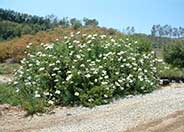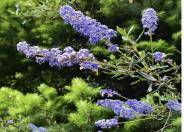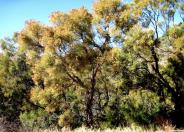
Common name:Matilija Poppy
Botanical name:Romneya coulteri
Crowned by white poppies, this high-impact, spreading gray-green perennial stands statuesque at 5-8" tall. It is best used where its scale and habit will not overpower, and it requires no summer water and thrives on dry alluvial slopes..

Common name:Parry's ceanothus, ladybloom
Botanical name:Ceanothus parryi
Nicknamed ladybloom, this ceanothus is underused in California gardens. Native to chaparral plant communities in the coast ranges of California and Oregon. Upright habit with arching branches growing 8-12 ft tall with dark green narrow leaves. Long, narrow flower clusters of medium to deep blue blossoms in the spring. A useful screen, specimen or informal hedge in full sun with little to no water once established. Tolerant of inland heat and conditions. Ceanothus are great additions to the habitat garden offering food and cover for birds and nectar for bees and butterflies. This CA native survives on rainfall once established, except during periods of prolonged winter drought.

Common name:Redshanks, Ribbonwood
Botanical name:Adenostoma sparsifolium
Redshanks is a multi-trunked tree or shrub in the Rosaceae (Rose) family that is native to dry inland slopes or chaparral of Southern California and northern Baja California below 6,000 ft. Shaggy falling shanks or ribbons of bark are one of the strongest characteristics of the tree, hence the common names. Redshanks are closely related to the more abundant Chamise (Adenostoma fasciculatum). Members of this genus are very deep rooted and important slope stabilizers. The foliage is feather-like, allowing the trunk and main branches to show through. The red and white flowers are small but attractive, blooming in summer and fall. The fruit is an achene which is valued by small birds. Red Shank is an attractive garden tree, especially when planted in a small grouping. It does best in full sun, growing upright from 6.5' to 20' tall and 10' wide. Plant on hillsides or use as a hedge or for a bee garden.
Designer: UC Berkeley
Photographer: Vicki Anderson
Incorporate compost 6" into your soil to retain water, reduce compaction, feed earthworms, and provide valuable nutrients to your plants.
Attract, or buy beneficial insects such as ladybugs and lacewings to control pest outbreaks in your garden.